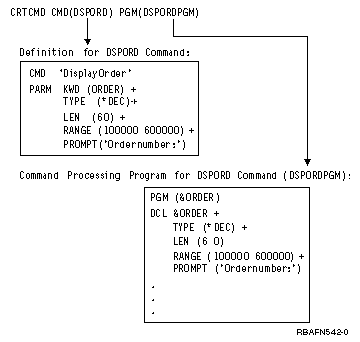This topic describes the command processing program for CL or HLL.
The figure below shows the relationship between the Create Command (CRTCMD) command, the command definition statements, and the command processing program for CL and high level languages (HLL).
If the command processing program is a program written in CL, the variables that receive the parameter values must be declared to correspond to the type and length specified for each PARM statement. The following shows this correspondence.
| PARM Statement Type | PARM Statement Length | Declared Variable Type | Declared Variable Length |
|---|---|---|---|
| *DEC | x y1 | *DEC | x y1 |
| *LGL | 1 | *LGL | 1 |
| *CHAR | n | *CHAR | ≤n2 |
| *NAME | n | *CHAR | ≤n2 |
| *CNAME | n | *CHAR | ≤n2 |
| *SNAME | n | *CHAR | ≤n2 |
| *GENERIC | n | *CHAR | ≤n2 |
| *CMDSTR | n | *CHAR | ≤n2 |
| *DATE | 7 | *CHAR | 7 |
| *TIME | 6 | *CHAR | 6 |
| *INT2 | n | *INT or *CHAR | 2 |
| *INT4 | n | *INT or *CHAR | 4 |
| *UINT2 | n | *UINT or *CHAR | 2 |
| *UINT4 | n | *UINT or *CHAR | 4 |
:
|
|||
A program written in CL used as a command processing program can process binary values (such as *INT2 or *INT4). The program can receive these values as character fields. In that case, the binary built-in function (%BINARY) can be used to convert them to decimal values. Otherwise, the CL program can declare them as integer variables.
The difference between *INT2 or *INT4 and *UINT2 or *UINT4 is that the *INT2 and *INT4 types are signed integers and the *UINT2 and *UINT4 types are unsigned integers. The default value for all integer types is 0. The *UINT2 and *UINT4 types have the same restrictions as the *INT and *INT4 types.
